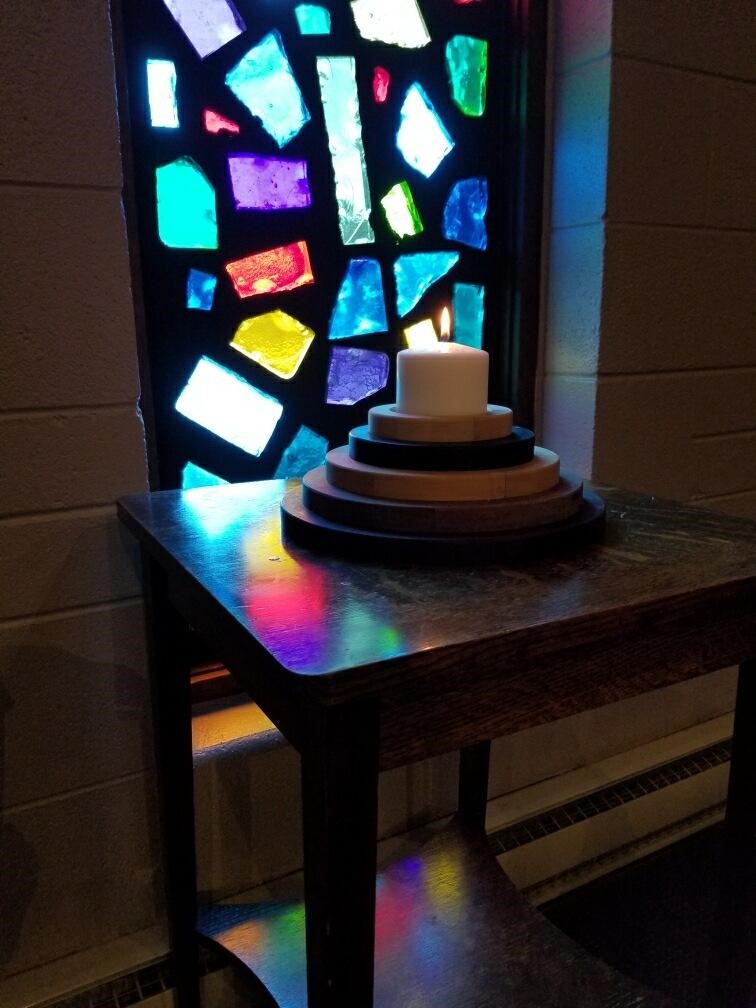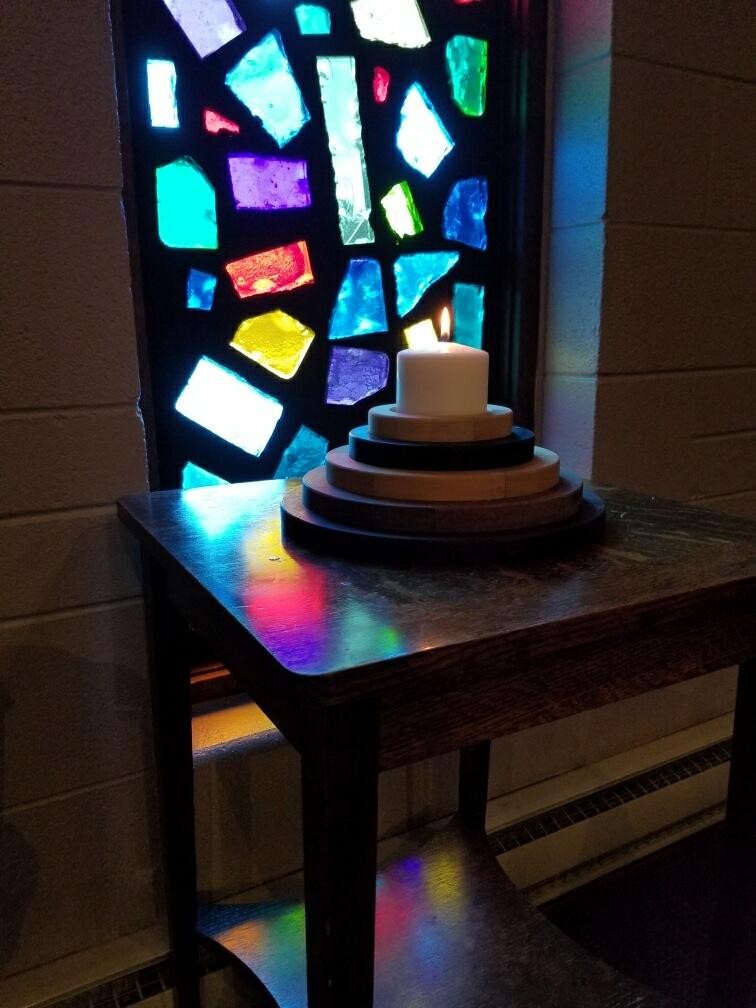
CMC Worship in Place | June 14
CMC Worship in Place for June 14 | Pride Sunday
As we forgo Sunday worship gatherings, we are offering a video service each week. The link to the video is sent out on Sunday morning along with prayer requests.
Welcome and Call to Worship | Jen Cartmel
Peace Candle | Stried Family
As we worship in place today, we light a Peace Candle in our home,
inviting you to light a Peace Candle in your home.
The flame joins us in spirit across distance, along with our sister church in Armenia, Colombia.
STJ 4 | You’ve got a place | Phil Hart
Children’s Time | Tim Stried
Pastoral Prayer | Jen Cartmel
Special Music | By Way of Sorrow* | Phil Hart
Scripture | Acts 8:26-36 | Jen Cartmel
Sermon | What Can Stop Us? | Mark Rupp
Hymn | There is a Time for Silence** | Phil Hart
Benediction | Mark Rupp
* Permission granted for use by artist.
** Words by Carolyn Gillette (used with permission); Music by Phil Hart
Sermon: What Can Stop Us?
Even though the pandemic has forced the Columbus Pride Parade and Festival to be postponed until October, we wanted to make sure we still recognize Pride month by remembering that Pride was never meant to be about parades and festivals. The initial spark that led to what we now know as Pride was, indeed, a protest against police brutality, and many people say the first brick was thrown by a Black Trans woman named Marsha P. Johnson.
We cannot celebrate Pride without also insisting that Black Lives Matter, without recognizing the way that the experiences of oppressed groups overlap and intersect. While our focus this morning will be on queer lives, we must never forget that none of us are truly free until all of us are free. I was inspired by a protest sign I…
CMC Worship in Place | June 7, 2020
CMC Worship in Place for June 7
As we forgo Sunday worship gatherings, we are offering a video service each week. The link to the video is sent out on Sunday morning along with prayer requests.
Welcome and Call to Worship | Julie Hart
Peace Candle | Shakita Kabicek
As we worship in place today, we light a Peace Candle in our home, inviting you to light a Peace Candle in your home. The flame joins us in spirit across distance, along with our sister church in Armenia, Colombia.
HWB 46 | I sing the mighty power of God | Katie Graber
Children’s Time | Jen Cartmel and Bill Plessinger
Graduating Seniors Blessing | Mark Rupp
Pastoral Prayer | Mark Rupp
Mission Moment | CCMP | Phil Hart
Scripture | Genesis 1:1-5; Psalm 8 | Patti Browning
Sermon | “Let there be…” | Becca Lachman
StJ 24 | Creation is a Song | Doug and Jude Krehbiel
Benediction | Julie Hart
Closing | 8:46 Minutes of Silence
Cookie Sunday via Zoom (link will be sent out on Sunday morning)
~~~
Sermon text:
“Let there be…”
Greetings, friends and church family, greetings strangers and wanderers. Welcome to this new day together/apart, in community and longing for the communities we know are possible. I’m recording this for you on the 2nd-story deck of my home in Athens, Ohio on my 80th day of sheltering in place.
Layers of this service so far might be making most of us homesick for our annual outdoor service, which usually happens about this time of year, a service where we’ve pondered and celebrated the natural world, and of course the epic potluck that follows. So I’m having a mini out-door service this morning, and I hope some of you get to, as well, even if you’re by an open window, hearing evidence of Creation pressed to your ear like a seashell.
In the verses from Genesis, we…

CMC Worship in Place | Pentecost Sunday | May 31
Prelude
Peace Candle | Gretchen Geyer and Thomas Leonard
As we worship in place today, we light a Peace Candle in our home, inviting you to light a Peace Candle in your home. The flame joins us in spirit across distance, along with our sister church in Armenia, Colombia.
Welcome and Opening | Joel Call
Call to Worship | Joel Call
Hymn | Holy Spirit, come with power | Tom Blosser, Debra and Galen Martin
Children’s Time | Kelsey and Mike Ryan-Simkins
Mission Moment | Comforter Blessing | Joyce Wyse
Pastoral Prayer and Offering Dedication | Robin Walton
Special Music | O healing river | Tom Blosser
Scripture | Acts 2
v. 1 – 2 | Japanese | Charlie Shenk
v. 3 – 4 | Spanish | Edith Espinal
v. 5 – 6 | German | Roberta Gerlach
v. 7 – 8 | French | Isaac Ruggles
v. 14 – 16 | Mandarin | Ruth Leonard
v. 17 – 18 | Turkish | Wilbur Miller
Sermon | Holy Spirit everywhere | Joel Miller
STJ 33 | Come, Holy Spirit, descend | Tom Blosser
Benediction | Joel Call
—————————-
Sermon Text
There’s a story in the Torah, the book of Numbers chapter 11. It takes place just after the Israelites depart from Mt Sinai where Moses received the teachings of the law. They are again on the move and they are again complaining about the lack of dining options in the desert. Nothing but this bland manna to eat. The people are upset, and this makes Moses, their leader, upset. Moses has it out with the Lord, Yahweh, saying that this is an impossible task, too heavy a burden to bear, and that if the Lord is indeed merciful, the Lord should end his life at once.
The Lord’s response is to have Moses gather 70 of the elders. Yahweh says, “I will take some of…

CMC Worship in Place | Easter 7 | Ascension Sunday | May 24
Easter 7 | Ascension Sunday
Prelude
Peace Candle | Lehman Family
As we worship in place today, we light a Peace Candle in our home, inviting you to light a Peace Candle in your home. The flame joins us in spirit across distance, along with our sister church in Armenia, Colombia.
Welcome and Opening | Sarah Werner
Call to Worship | Sarah Werner
HWB 298 | Veni Sancte Spiritus | Paul Knapke
Children’s Time | Jon Lucas
Pastoral Prayer and Offering Dedication | Mark Rupp
Special Music | Bach Minuet I: Partita No. 3 in E Major | Alexander Martin
Scripture | Acts 1:6-14 | Larry Less
Sermon | Ascension, grief, falling | Joel Miller (Manuscript below)
Grief in 100 Words | Dan Lehman, Lavonne van der Zwaag, Jerry Nussbaum, Bethany Davey, Matthew Leahy, Laurie Zimmerman
Interludes | STS 45 | Calm Me Lord | Phil Yoder
STS 121 | Nothing is lost on the breath of God | Paul Knapke
Benediction | Sarah Werner
Christian Education | Mental health during pandemic | Jenny Campagna interviewed by Mark Rupp
Sermon
Ascension, grief, falling | 24 May 2020
I remember the moment each of our daughters was born. I remember how it felt. How my body responded. Each time was similar. At the moment of birth my body reflexively took a huge in breath. Like the world was now instantly a fuller place and my body had to expand to rise to the occasion. This was followed by tears – not attached to any particular emotion I can name other than beholding the wonder of what just happened. A life fills the room, a breath fills the body to the point of overflowing.
This happened three times: Eve, Lily, Ila.
There was a fourth birth, third in chronological order. 11 years ago this past Thursday Belle was stillborn. With labor beginning only 22 weeks into the complicated pregnancy, we knew Belle…

CMC Worship in Place | Easter 6 | Membership Sunday | May 17
Easter 6 | Membership Sunday
Prelude | Katrina Cortes
Peace Candle | Britni, Jeff, Micah, and Blaise Lookabaugh
As we worship in place today, we light a Peace Candle in our home, inviting you to light a Peace Candle in your home. The flame joins us in spirit across distance, along with our sister church in Armenia, Colombia.
Welcome and Opening | Joel Miller
Call to Worship | Adam Glass, Victoria Schrock, Meaghan Torres, Will Kentris
HWB 356 | Breathe on me, breath of God | Debra, Galen, Sarah, and Elizabeth Martin
Children’s Time | Mark Rupp
Membership Commitment Statement | New members
Pastoral Prayer and Offering Dedication | Joel Miller
Special Music | Excerpt from Wedding Day at Troldhaugen Op. 65 no. 6 by Edvard Grieg | Katrina Cortes
Scripture | John 14:15-21 | Jared Crowe and Katie Kramer
Faith journey reflections | New members
STJ 2 | Come walk with us | Debra, Galen, Sarah, and Elizabeth Martin
STJ 87 | Put peace into each other’s hands | Debra, Galen, Sarah, and Elizabeth Martin
Benediction | Joel Miller
Communion* | 11 am via Zoom
*We practice an open Communion table and all who hunger and thirst for God are welcome to participate.
…
